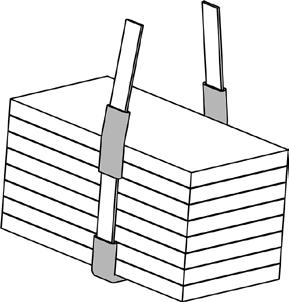
3 minute read
General Information
from 2024 Catalog
by Lift-All
GENERAL OSHA & MANUFACTURER REQUIREMENTS FOR ALL SLINGS
Safe Operating Practices
Advertisement
1. Sling users must be trained in operating practices, including sling selection, use, inspection, rigging practices, cautions to personnel, and effects of the environment.
2. Inspect sling before each use and remove from service if damaged.
3. Protect sling from being cut or damaged by corners, protrusions, or from contact with edges that are not well rounded, using material of sufficient strength, thickness and construction to prevent damage.
4. Use sling properly. Do not exceed a sling's rated capacities and always consider how the sling angle affects the amount of tension on the sling.
5. Stand clear of the load. Do not stand on, under, or near a load, and be alert to dangers from falling and moving loads, and the potential for snagging.
6. Maintain and store sling properly. The sling should be protected from mechanical, chemical and environmental damage.
1. TRAINING
Sling users must be trained and knowledgeable Sling users must be knowledgeable about the safe and proper use of slings and be aware of their responsibilities as outlined in all applicable standards and regulations.
ASME B30.9 states, “Sling users shall be trained in the selection, inspection, cautions to personnel, effects of the environment, and rigging practices.”
OSHA Sling Regulation 29 CFR 1910.184 states that a qualified person is one “who, by possession of a recognized degree or certificate of professional standing in an applicable field, or who, by extensive knowledge, training, and experience, has successfully demonstrated the ability to solve or resolve problems relating to the subject matter and work.”
If you are unsure whether you are properly trained and knowledgeable, or if you are unsure of what the standards and regulations require of you, ask your employer for information and/or training — DO NOT use slings if you are unsure of what you are doing. Lack of skill, knowledge or care can result in severe INJURY or DEATH to you and others.
2. INSPECTIONS
Damaged or defective slings shall be immediately removed from service.
Inspection Frequency
Initial Inspection Each new sling must be inspected by a designated person to help ensure that the correct sling has been received, is undamaged and meets applicable requirements for its intended use.
Frequent Inspection Slings must be inspected for damage before each use by the user or other designated person. Refer to safety bulletin provided with each sling.
Periodic Inspection Every sling must be inspected periodically. The designated person should be someone other than the person performing the frequent inspection.
The frequency of periodic inspections should be based on the sling’s actual or expected use, the severity of service and experience gained during the inspection of other slings used in similar circumstances, but must not exceed a one-year interval. General guidelines for the frequency of periodic inspections are:
• Normal service — yearly
• Severe service — monthly to quarterly
• Special service — as recommended
A written record of the most recent periodic inspection must be maintained. See WSTDA WS-1 for definitions of service conditions.
For specific inspection criteria for Lift-All slings, see the information at the end of each product section.
All sling users must read and understand the safety bulletin provided with each sling.
The Safety Bulletin that accompanies each sling must be read and understood by all sling users. See sling abuse illustrations in their respective section of this catalog. Damaged slings should never be used. It is possible (in some instances), to repair slings, proof-test and return them to service. Damaged components and sections of chain or wire mesh can be replaced. Hooks, links and other components that are in good condition can be salvaged from a damaged web or round sling; then re-webbed and proof-tested by Lift-All and returned to service.
GENERAL OSHA & MANUFACTURER REQUIREMENTS FOR ALL SLINGS
3. PROTECT SLINGS
The cutting of synthetic slings is the primary cause of sling failure, usually caused by a sharp or small diameter load edge against the sling. Proper protection must be used to avoid cutting. (See Sling Protection section).
Heavy abrasion will seriously degrade sling strength. Rough load surfaces and dragging slings on the ground will damage all slings, steel or synthetic. Use proper sling protection between slings and rough loads. Never drag slings on the ground or concrete floors.
Sling Protection
A qualified person must select materials and methods that adequately protect slings from edges or surfaces. The sling protection section of this catalog includes information on available cut protection products and wear protection products. No protective device is cut proof.
Some protection devices provide abrasion resistance but offer virtually no protection against cuts. Several test lifts (done in a non-consequence setting), may be necessary to determine the suitability of each protection device. After each test lift, inspect all slings and protection devices for damage.
Foreign Matter
Material such as metal chips and heavy grit can damage slings, both internally and externally. Avoid contact with foreign matter whenever possible.
4. USE SLINGS PROPERLY
Improper Loading — Shock Loading, unbalanced loading, overloading and inadequate consideration for the effect of angle factors can adversely affect safety. Make sure the load weight is within the rated capacity of the sling(s) being used for both type of hitch, and angle of lift. OSHA wording.

Slings should not be dragged on floor.
Do not shock load. Jerking the load could overload the sling and cause it to fail.
Right Way
Wrong Way
Lift must be stable and balanced with respect to the center of gravity.










